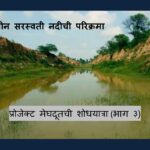Deletion in microbial communities jeopardizes the health of river Ganga.
National Center for Microbial Resource (NCMR) – National Center for Cell Science (NCCS) and Center for Citizen Science (CCS) through their joint initiative worked to characterize the microbial diversity of India’s prominent river, the Ganga. This study was initiated in July 2015 and samples were collected form the five locations along the length of the river including its origin in Gomukh to the point where it discharges into the Bay of Bengal. Thus, elucidating the type of microbes in river Ganga motivated us to conduct a research on “how microbial diversity shifts” due to anthropogenic interventions. This work would aid to devise policies for the Clean
Ganga Mission. This study is published in September issue of Current Microbiology.
CCS works through the participation of citizens and students alike who share the excitement of doing science. Since, 2011 CCS is active in Meghdoot project, which aimed to monitor Indian monsoon. Under this project CCS also collected samples from 5 different sites along the river Ganga starting from its origin i.e. Gomukh, Gangotri, Kanpur, Varanasi and Ganga sagar (mouth of Ganga in Bay of Bengal). The samples from these locations were collected by considering the anthropogenic load on the river. The samples were sent to NCMR- NCCS for the further microbiome analysis.
In their course of research over the past 2 and half years researchers at NCMR have mapped the changes in bacterial diversity along the course of river. Gomukh being the origin of the river microflora present here are the true residents of the river Ganga, even at Gangotri these naturally occurring microorganisms were found predominantly. However, few species of human associated microbes were also detected at Gangotri. Further south Ganga and tributaries flow along vast plains have heavy human population which jeopardizes the health of river.
Investigations revealed that naturally resident microbes being depleted with ~52% of microbial communities at urban sites due to anthropogenic activities. Additionally, “The unrestricted human usage along the bank of river Ganga including ritual practices and industrialization might have pronounced influence on the river microbial communities which couldn’t be ignored either. “The sites under study demonstrated the establishment of unique microbial signatures which could represent the impact of spatial variation on the microbial communities of river Ganga. This emphasizes the fact of varied anthropogenic pressure experienced by microbial communities of river Ganga.
This study highlights the need to understand the introduction of industrial effluents and human associated microbes and, its implications on the river ecosystem and public health. The comparison depicted in the present study involving samples from the rural site along with urban sites of river Ganga which holds great promise and would certainly aid to Namami Gange: a clean Ganga initiative by Government of India. Therefore, a much detailed investigation
considering aesthetics, seasonal variation and human engagement along the river Ganga would provide a more holistic view on the health of river and its implications on the human health. Another highlight of this study is also how interested citizens, students and researchers can come together and contributes towards betterment of science. Study was conducted at NCMR-NCCS by the team of 5 researchers named Mr. Kunal Jani, , Dr. Avinash Sharma, Dr.Yogesh Shouche, Dr. Shrikant Pawar and Mr. Vikas Ghattargi while MS Mitali Inamdar, Mr. Nitin Tahmankar, Mr. Kiran Thombare and Mr. Mayuresh Prabhune of Center for Citizen Science, Pune was also a part of the study.










Leave a Reply